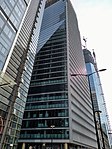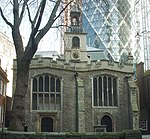Bishopsgate

Bishopsgate was one of the eastern gates in London’s former defensive wall. The gate gave its name to the Bishopsgate Ward of the City of London. The ward is traditionally divided into Bishopsgate Within, inside the line wall, and Bishopsgate Without beyond it. Bishopsgate Without is described as part of London's East End.The ancient boundaries of the City wards were reviewed in 1994 and 2013, so that the wards no longer correspond very closely to their historic extents. Bishopsgate Without gained a significant part of Shoreditch from the London Borough of Hackney, while nearly all of Bishopsgate Within was transferred to other wards. Bishopsgate is also the name of part of the originally Roman Ermine Street (now the A10) within the traditional extent of the Ward.
Excerpt from the Wikipedia article Bishopsgate (License: CC BY-SA 3.0, Authors, Images).Bishopsgate
Bishopsgate, City of London
Geographical coordinates (GPS) Address Nearby Places Show on map
Geographical coordinates (GPS)
| Latitude | Longitude |
|---|---|
| N 51.5163 ° | E -0.08145 ° |
Address
Heron Tower
Bishopsgate 110
EC2N 4AD City of London
England, United Kingdom
Open on Google Maps









